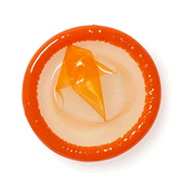When it comes to condoms, two is definitely not better than one. Using two condoms or a condom and an internal condom at the same time can create more friction, which increases the chances the condom(s) will break. If you want extra pregnancy prevention, double up with a condom and an effective method of birth control.
- Birth control
- Condom
- FAQs
Condom

What's the deal with double bagging?
Want to learn more?
What if I'm allergic to latex condoms or my partner is?
Latex allergies are rare, but they happen. If you or your partner are allergic to latex, there are non-latex polyurethane condoms you can use to protect against pregnancy and STIs. Lambskin condoms are another option for preventing pregnancy, but they don’t protect against STIs.
No other methods of birth control contain latex, so you can safely use them if you or your partner has a latex allergy.
How much does it cost to use condoms?
For the most part, condoms are a relatively cheap method compared to other types of birth control, but since you have to use one every single time you have sex, they will be more cost effective if you have sex less frequently.
Check with your local family planning clinics and find out if they offer free or low cost condoms and other kinds of birth control (most do). If you can’t get them for free, they’ll probably cost anywhere from $0.18 to $1.83, though these prices are from a survey of online retailers, so prices at the store may vary slightly.
I'm tired of using condoms, is there another birth control method that will also protect me from STIs?
Yes, try using an internal condom. It’s a barrier method that’s inserted into the vagina (instead of covering the penis, like an external condom) that will help protect against sexually transmitted infections (STIs) as well.
Is it true that most condoms are about the same size—even Magnums?
Magnums are a little bigger than regular condoms, but the truth is, most men don’t need ‘em. Regular-sized condoms will work for most. If you can stretch a condom over your hand, it will also fit on most penises. For a little more on the subject, check out 2 big 2 fit.
Want to learn more?
If I'm using another method of birth control, do I still have to use condoms?
It depends on your situation. Unless you’re in a totally exclusive relationship and you and your partner have both been tested recently for every single STI, using condoms with whatever other birth control method you choose is a good idea. Basically, if there’s any chance you or your partner could have an STI, the only way to decrease the risk of transmitting it is by using condoms, internal condoms, dental dams, and/or PrEP, (a medication which decreases the risk of getting HIV.) Other forms of birth control don’t protect against STIs.
Using a condom with another form of birth control is called dual protection. It means you’re being super-safe and protecting yourself against both pregnancy and STIs.
What types of lube are safe to use with latex condoms?
Both water-based and silicone-based lubricants are totally safe to use with latex condoms. Steer clear of oil-based lubricants (including massage oil, hand lotion, and Vaseline) that can cause condoms to break.
Want to learn more?
Can I reuse a condom?
Condoms are definitely not reusable. You need to put on a new one each and every time you have sex.
Want to learn more?
What types of birth control are available over the counter?
Condoms, internal condoms, spermicide, and emergency contraception are all available at your nearest pharmacy.
Want to learn more?
Do condoms prevent HPV?
HPV cannot pass through a latex condom. But this is the kicker: HPV is frequently carried on skin not covered by condoms. So condoms can help prevent HPV, but they’re not a guarantee.
Want to learn more?
Is oral sex safer than vaginal sex?
You can’t get pregnant from oral sex, but you can get an STI (sexually transmitted infection). So use condoms or dental dams and get tested regularly.
Want to learn more?
Can I tell if someone else has an STI?
To protect yourself against STIs, use condoms or internal condoms.
No. It’d be great if you could tell who had an STI (sexually transmitted infection, a.k.a. STD) and who didn’t, but the most common symptom of all STIs is no symptom at all. STIs are often asymptomatic or display such mild symptoms they go unnoticed and/or are mistaken for something else. For that reason, most people with an STI are unaware they have one.When STIs are asymptomatic or exhibiting mild symptoms, they’re still transmittable to others—and there’s no guarantee the STI will remain asymptomatic in the newly infected individual. Recognizable symptom or not, STIs can wreak havoc internally long before we’re aware of their effects; untreated asymptomatic STIs can pose long-term health risks like liver damage (eg. Hepatitis) and infertility (eg. Chlamydia and gonorrhea).
To protect yourself against STIs, use condoms or internal condoms.
Want to learn more?

Heat up your weekends with our best sex tips and so much more.